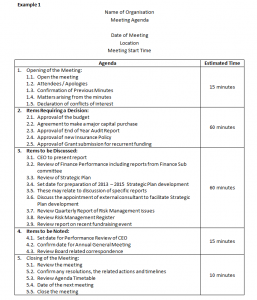The main elements or categories of the meeting agenda should be similar for each meeting. The content under each element or category will obviously change from meeting to meeting.
This doesn’t mean that you don’t add new elements or categories, but by having a consistent format for each meeting it allows your meeting to address relevant issues and helps keep the meeting focused on the issues which are important. It is especially important when decisions need to be made.
The agenda provides a systematic and orderly way to manage the meeting and the business of the organisation.
The elements of the meeting agenda will differ from organisation to organisation as there are many different styles and formats. For example, one type of format sets out the agenda based on a process model.
In Example 1 below (click on the image for a larger view) the main agenda items highlighted in bold are categorised based on what needs to be done with the information. The example used highlights a format and guide for the type of information that may be under each element.
Another type of format sets out the agenda based on a function model. Refer to Example 2 (click on the image for a larger view) as the main agenda items highlighted in bold are categorised based on what organisational functions the information relates to. The following example highlights a format and a guide for the type of information that may be under each element.
In both formats you will notice a column in the right listing an estimated time for each element. Not only will this help you stick to time in the meeting, it will show you, as you are preparing your agenda, whether everything is likely to fit into a reasonable meeting time frame. There is no point in overcrowding your agenda and racing through issues which need real consideration and discussion. If the times look like leading to a marathon meeting, it makes sense to hold some topics over until the next meeting.
Irrespective of whether you use one of the above examples or a different format, the main issue is to ensure it relates to your organisation. Remember, the agenda provides a systematic and orderly way to manage the meeting and the business of the organisation.
Which format would suit Robin Hood and his Merry Men? Which would suit your not for profit?

 Posted on 20,Sep |
Posted on 20,Sep |
 Posted by Anne
Posted by Anne 






Comments
By The Finance Subcommittee – Admin Bandit
12 years ago
[...] recent posts have covered issues associated with preparing the agenda, the key elements of an agenda as well as the use of an agenda timetable to assist with scheduling relevant issues throughout the [...]
By Preparing for the board meeting – Admin Bandit
12 years ago
[...] [...]